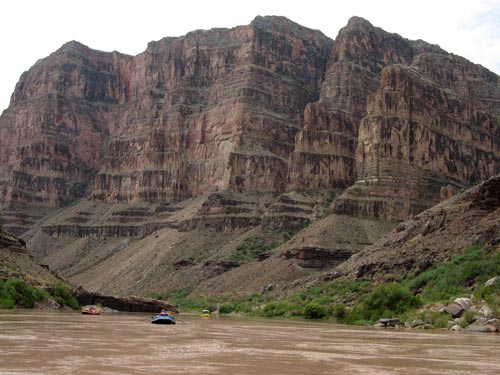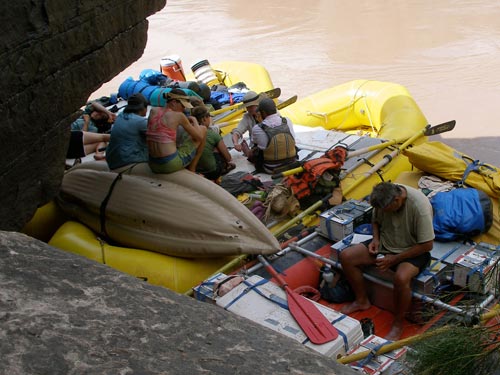The morning remained overcast. It was very humid but also very slow in getting too hot. We still had to be wary of potential flash floods. We loaded up and continued on our way.

Mist creeps into Camp 209. The beaches are often very steep and undercut from erosion from the boats and tides

The landscape changes yet again.

Pumpkin Spring at mile 213 is probably the only truly dangerous water in the Grand Canyon. The orange color is caused by arsenic, with measured levels of 1,100 milligrams/liter (the state health standard is 50 milligrams/liter). Arsenic in large amounts is extremely toxic and the National Park Service advises no entry.
Care should be taken when drinking any of the water. Even clear tributaries should be filtered because the simple act of filling a water bottle can stir up the sediments that hold bacteria. It is also wise to avoid water with high amounts of dissolved chemicals, minerals and trace metals. Even a clear stream can have high levels if it passes through the right rock layers, for example. These levels may be entirely natural but can still cause digestive issues since they can't usually be filtered out because of the tiny nature of the elements involved. Streams with low levels include Vasey’s, Thunder River, Shinumo, Tapeats, Deer and Bright Angel, which all emerge from the Redwall or Muav limestones off the North Rim.

Note the source of the spring, the water bubbling up on the right


The towering cliffs that surround the spring

Even out here, there is still evidence of lava flows.


There are around 10,000 species of millipedes.
Millipedes are arthropods that have two pairs of legs per segment. They are slow moving and will often coil into a ball when threatened. They are herbivores (eating mostly damp and decaying wood and plants), harmless and brown in color. In contrast, centipedes only have one pair of legs on each body segment. They are can move very quickly. They are carnivores (eating other insects, caterpillars and even mice), poisonous (with a venomous bite) and brightly colored to warn other animals how dangerous they are.

The Plateau Tiger Whiptail (or Painted Desert Whiptail) In some species of whiptail lizards, there are no males. Parthenogenesis is a form of asexual reproduction in which females produce eggs that develop without fertilization.

We then went a bit further to Three Springs Canyon at mile 215.5 and had lunch. We parked the boats under shady overhang.

A view of the cliffs across the river

Having lunch in the only tiny spot of midday shade on the river
The Boatman’s Almanac (by Jeff Sorensen) lists the sunrise and sunset times for months of the year at popular camp sites. It helps boatmen find sun in winter and shade in summer.

Diamond Peak is hard to miss. Diamond Peak, along with Diamond Canyon, was named by Army Lt. Joseph Ives and Dr. John Newberry in 1858. It stands 3,512 feet high.
Our last night was at Camp 224. After dinner, we all packed what we could to prepare for a very early (and hectic) morning.
return • continue

